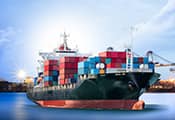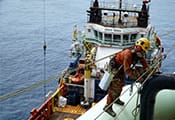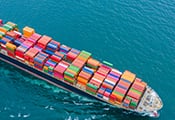Full Container Load (FCL)
FCL, or Full Container Load, means booking an entire container for one consignee's cargo only. The shipper doesn't share the container with others, which improves security and makes logistics easier.
When to consider FCL:
- Ideal for bulky and heavy cargo that fills a whole container.
- Ensures the container's goods belong to one company, avoiding sorting and unpacking at multiple ports.
- Offers faster delivery and reduces the risk of delays.
Less than Container Load (LCL)
LCL, or Less than Container Load, is used when the cargo is too small to fill an entire container. It is a cost-effective option for smaller, less time-sensitive shipments. Freight forwarders typically combine several LCL shipments into one FCL container and then sort the cargo based on their destinations.
Other than FCL/LCL, there are other modes of shipment:
- FCL/FCL: The shipper's package travels in a container and is delivered directly to the recipient.
- LCL/LCL: Packages from several shippers are grouped into one container and then separated at the destination for delivery to multiple recipients.
- LCL/FCL: Packages from several shippers are grouped into a single container and delivered to one recipient.
Choosing the Mode of Shipment: FCL or LCL
Selecting the right shipment mode is crucial for minimizing transport costs. For instance, LCL (Less than Container Load) is cost-effective when goods do not fill an entire container (less than 15 cubic meters). LCL also offers savings on storage by allowing smaller, more frequent shipments.
However, security is another important factor. LCL shipments involve more loading and unloading (breaking bulk), increasing the risk of damage, loss, or theft. Clients who prioritize secure transport often prefer FCL (Full Container Load). With FCL, the container is sealed after loading and remains closed until it reaches its destination, ensuring greater security.
Features of Containers
Containers come in various designs to accommodate different cargo types. Some common container features include tunnel design with double doors, open-sided containers with pull-down doors, double open-sided containers, open-top containers with removable tarpaulin roofs, refrigerated containers for perishable cargo, flat rack containers without roofs and side panels for oversized cargo, and tank containers for liquid cargo.
Examples and Practical Applications: FCL/LCL Shipments in Practice
Example: TechWidgets Inc.
TechWidgets Inc., a company specializing in electronic components, frequently ships its products internationally. The company uses standard ISO containers with dimensions of 8 feet in width and either 20, 30, or 40 feet in length.
Scenario
Using FCL Mode: TechWidgets Inc. has a large order of electronic components that fills an entire 40-foot container. By opting for FCL, they are billed based on the cubic meter or ton, depending on the shipping terms. This method proves cost-effective as FCL is generally cheaper than LCL for larger shipments. The reduced handling operations lead to faster delivery, as there is no need to group or separate goods, minimizing delays. However, the price of FCL can fluctuate based on available space on ships.
Using LCL Mode: For smaller, less frequent shipments, TechWidgets Inc. chooses LCL. This allows them to ship smaller volumes more frequently, saving on storage costs. They are billed per cubic meter or ton. Despite the cost savings, the increased handling operations with LCL raise the risk of damage, loss, or theft, and can lead to delays due to the need to group and separate goods.
Freight Forwarder Assistance: To streamline their shipping process, TechWidgets Inc. employs the services of a freight forwarder, GlobalFreight Solutions. The freight forwarder is responsible for finding the most efficient transport solutions for TechWidgets Inc. They choose the best modes of transport, handle consolidation (grouping and separating), manage transshipping, and take care of all formalities.
TechWidgets Inc. benefits from both FCL and LCL modes depending on the size and frequency of their shipments, with the guidance and expertise of their freight forwarder ensuring optimal logistics management.
The Different Stages of FCL/LCL Shipment:
A French manufacturer wants to ship goods to China to be sold in various supermarkets. He opts for the FCL/LCL shipment mode.
- The consignment is transported by truck to the port of departure.
- The goods go through customs clearance.
- The packages are unloaded from the truck and loaded into a container.
- The container is loaded onto the cargo ship.
- The cargo ship arrives at the destination port in China.
- At the port, the container is unloaded.
- The container is opened, and the packages are separated according to the different recipients.
Conclusion
Choosing between FCL and LCL modes of shipment is crucial for optimizing costs, security, and efficiency. FCL is ideal for large, secure shipments with faster delivery, while LCL is cost-effective for smaller, frequent shipments despite increased handling risks. Understanding the differences and applications of each mode, along with leveraging the expertise of freight forwarders, ensures effective logistics management and smooth international shipping operations.



































 Expert advice made easy
Expert advice made easy


